People are different. Like snowflakes or fingerprints, there are no two identical personalities. Yet, we still have shared patterns of behavior, traits, and desires, which allow us to identify certain groups.
The feminine archetype test is a fun way to identify the kind of energy you have, how you build relationships with others, and what values drive you throughout life. Take it now to find out where your feminine power lies and how to embrace its true power.
Quick feminine archetype test
Choose one or a few answers in each question to learn more about your inner world. Don’t dwell on the questions for too long, but pick something that feels right to you.
1. What motivates you the most in life?
- A. Power
- B. Passion
- C. Freedom
- D. Adventure
- E. Service
- F. Knowledge
- G. Spiritual growth
2. How do you approach challenges?
- A. Make decisions and take control of the situation
- B. Follow my emotions
- C. Face problems with courage
- D. See them as opportunities to learn
- E. Try to support everyone involved
- F. Analyze and seek logical solutions
- G. Trust my inner guidance
3. What role do you naturally take in a group?
- A. I am the leader who organizes everyone.
- B. I bring people together and create a lovely vibe.
- C. I inspire others and motivate them to reach more.
- D. I keep things light and fun.
- E. I make sure everyone feels supported.
- F. I observe different aspects of the situation.
- G. I guide others to reconnect them with their soul.
4. What do you value the most in yourself?
- A. Ability to lead
- B. Passion and emotional depth
- C. Independence and strength
- D. Curiosity
- E. Kindness
- F. Intelligence
- G. Deep connection to the unseen
5. Which activity would you like the most?
- A. Running a business
- B. Spending time with my loved ones
- C. Traveling to another country alone
- D. Visiting a workshop
- E. Hosting a cozy dinner for family and friends
- F. Reading or learning something new
- G. Meditating and daydreaming
6. How do you want others to describe you?
- A. Powerful and independent
- B. Loving and magnetic
- C. Strong and unstoppable
- D. Fun and full of life
- E. Caring and trustworthy
- F. Wise and thoughtful
- G. Mysterious and inspirational
7. How do you usually make decisions?
- A. Think about the long‑term results
- B. Consider how it will influence others
- C. Start taking actions immediately
- D. Go with the flow and see what happens
- E. Think about its impact on my loved ones
- F. Weigh all options carefully
- G. Turn to my intuition
8. Which character do you associate yourself with most?
- Daenerys Targaryen from Game of Thrones
- Marilyn Monroe
- Katniss Everdeen from The Hunger Games
- Rapunzel from Tangled
- Molly Weasley from Harry Potter
- Princess Leia from Star Wars
- Luna Lovegood from Harry Potter
Dominant archetype test results
Now you’re ready to find out your kind of feminine energy. It’s OK if you have the same number of answers in different categories. People might embody a combination of a few archetypes.
Most A. Queen archetype
Such women are natural leaders who always know what to do next, remain calm in challenging situations, and have the confidence to make decisions that affect everyone around them. Women with this archetype are wise and feel deeply connected to their life purpose. Other traits of Queen include:
- authority
- strong feeling of responsibility
- ability to persuade others
- sense of dignity
This archetype is associated with the Greek goddess Hera, Elsa from Frozen, and Miranda Priestly from The Devil Wears Prada.
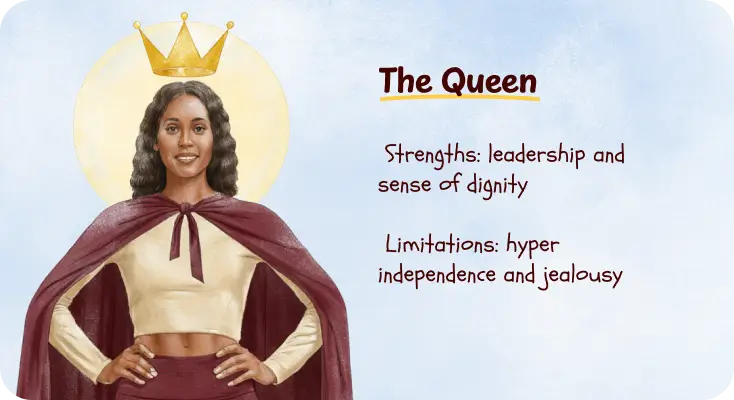
Limitations of the Queen archetype and ways to handle them
Women with the archetype of the Queen may be rather jealous and lack trust in others. They can try to handle everything alone, as ‘no one can do it better than me.’ Even though highly independent, they need to learn to delegate and accept that sometimes they might be vulnerable.
Hyper independence might be a result of childhood trauma. Take a 5-minute free quiz to find out whether you were traumatized and get personalized recommendations.
Most B. Lover archetype
If your feminine archetype is a Lover, this means you’re charming and passionate. Such women tend to strive for meaningful relationships and look for an ideal partner. Sex life and physical intimacy are important parts of their self-expression. Other traits of such a person are:
- ability to build deep emotional connections
- natural charisma that draws people in
- empathy
- appreciation for beauty and art
Among famous characters who have such feminine energy are Hazel from The Fault in Our Stars and Rose from Titanic.

Limitations of the Lover archetype and ways to handle them
Lovers tend to overidealize their partners, fall in love quickly, and fear being alone. They might also be excessively emotional. To feel more empowered, they need to build self-worth outside of relationships, practice emotional regulation, and find their passions and goals apart from relationships with others.
Most C. Huntress archetype
These women are full of inner strength, a sense of might, dignity, and independence. They know what they want, and a strong sense of self makes them unstoppable in achieving their goals. This archetype can also be called “Wild Woman” because the energy of these people is strong and unstoppable. Among other traits are:
- overcoming challenges with resilience
- goal-oriented mindset
- extreme autonomy
- adventurous spirit
Arya Stark from Game of Thrones, a Greek goddess Artemis, and Wonder Woman are classic examples of the Huntress archetype.
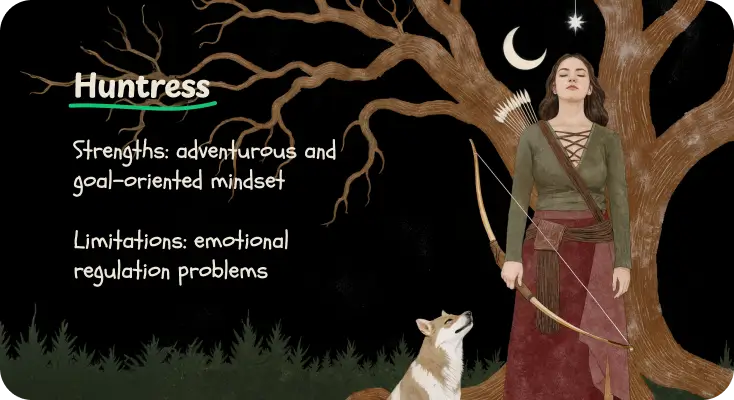
Limitations of the Huntress archetype and ways to handle them
The shadow side of the Wild Woman archetype is that such women may be rather emotionally distant. They can reject social norms and even get aggressive if something goes wrong. To build nurturing relationships with others without betraying themselves, they might need to learn to be vulnerable, ask for help, and practice patience when things don’t go according to plan.
Find out how you tend to handle anger and learn the ways to do it more efficiently. Take a quick & free test to get personalized insights.
Most D. Maiden archetype
This feminine archetype is often associated with youth, innocence, and optimism. Such women tend to believe in the good in people and find inspiration in their dreams. They are curious, kind, and loyal. Other traits of the Maiden include:
- optimism
- playfulness
- emotional sincerity
- strong imagination
Among the famous characters who have the soul of a Maiden are Bella Swan from Twilight, Snow White, and Cinderella.

Limitations of the Maiden archetype and ways to handle them
The shadow side of this feminine archetype lies in the fact that a person might be too naive, fall victim to learned helplessness, and be afraid of judgment. It’s important to cultivate self-worth, learn to set boundaries, and develop a more serious approach to different aspects of life.
Most E. Mother archetype
This term speaks for itself. This wise woman wants to take care of others and surround them with love and comfort. Women with the Mother archetype are protective, compassionate, and empathetic. Other traits include:
- responsibility
- talent for guiding and mentoring
- patience
- ability to create a safe and nurturing environment
Mary Poppins, The Fairy Godmother, and Mother Theresa have the Mother personality type.
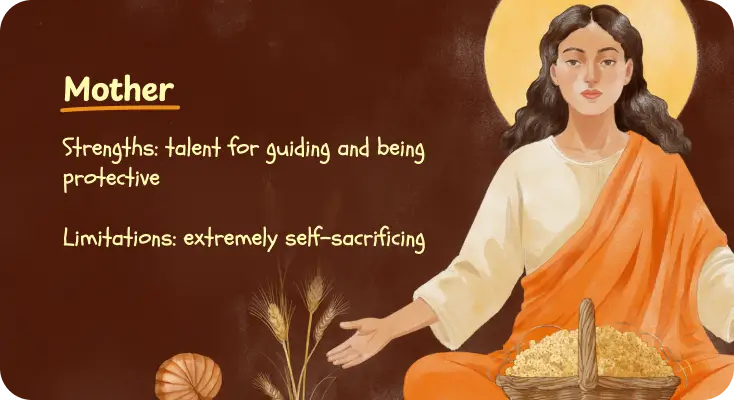
Limitations of the Mother archetype and ways to handle them
The truth is that such people might be extremely self-sacrificing and neglect their own needs. On the other hand, they might consider some of their actions like care, but in reality, it can turn into control. It’s vital to let the situation go and remember that others can make their own choices.
Most F. Sage archetype
This female archetype strives for knowledge, learning, and improving self-awareness. They are great mentors, teachers, or philosophers. Such wise women constantly seek the truth and engage in advanced knowledge and inner transformation. They’d rather read a good book than go to a party on weekends. Among other traits are:
- analytical and reflective thinking
- curiosity
- strong intuition combined with logic
- patience
Characters that have a Sage archetype energy are Belle from Beauty and the Beast and Hermione Granger from Harry Potter.
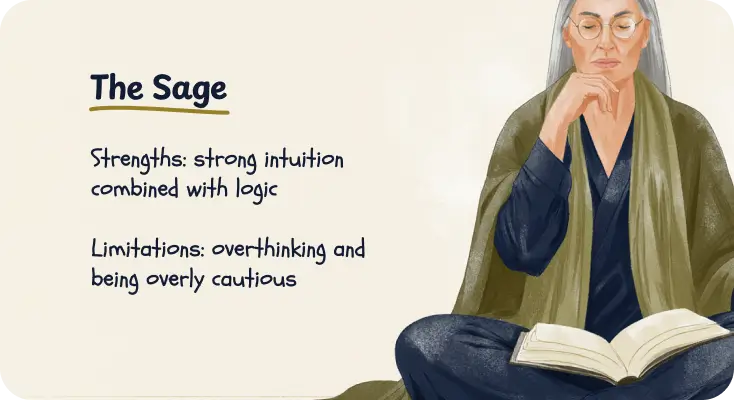
Limitations of the Sage archetype and ways to handle them
While such women constantly discover something new, they tend to overthink everything and can be overly cautious. To embrace their full power, they need to appreciate that wisdom also comes with experience, and making mistakes is a powerful tool for growth.
Most G. Mystic archetype
Women with the Mystic feminine archetype are mysterious and full of dreams. They follow their inner journey sometimes without even noticing the world around them. These people are more introverted than other archetypes and quite introspective. Some other traits include:
- heightened sensitivity
- inner peace
- connection to nature
- desire for creative expression
Luna Lovegood from Harry Potter and Melisandre from Game of Thrones are examples of this feminine archetype, as they are connected with their inner self on a deeper level.
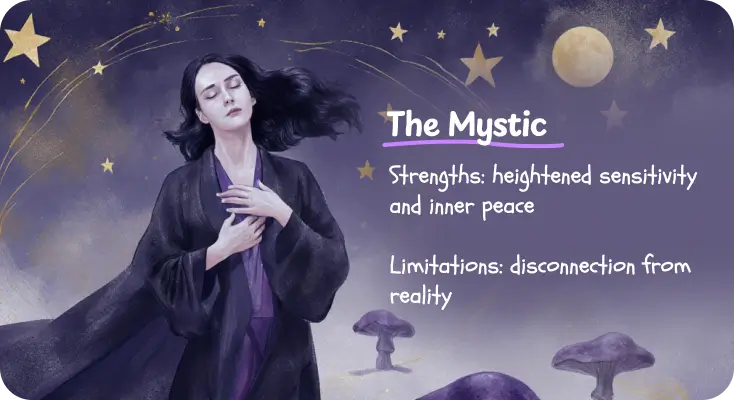
Limitations of the Mystic archetype and ways to handle them
The shadow side of this female archetype is excessive introversion and disconnection from reality. Such women need to find a balance between spirituality and real life. Supporting meaningful connections can also help them feel grounded and present in the moment.
Feminine archetypes and psychology. What’s the connection?
There is no scientific basis for feminine archetypes. Nevertheless, the main idea stems from Carl Jung’s archetypes, which are deeply rooted patterns in the collective unconscious that remain stable across cultures. [1] Even more, the scientist suggested the term “shadow side” — a kind of inferior personality that contains traits we usually hide or deny. [2]
Later on, the idea of archetypes revolutionized and evolved beyond Jung’s concepts. Now, some psychologists and life coaches can use them for self-reflection, understanding strengths, and emotional patterns.
Have you ever heard about the concept of human archetypes before?
Limitations of the divine feminine archetypes concept
It might be a problem that a person identifies their most dominant archetype and sticks to it without any further consideration. All of us are different, and we need to adapt to various roles according to life circumstances.
For instance, if the task requires leadership skills and ability to persuade others, it’s better to bring out your inner Queen instead of the Lover or the Sage. And while in daily life you might be more calm and reflective, self-awareness means that you can approach various situations differently from the position of power.
Even more, the concept of archetypes keeps evolving, and many debates are still ongoing. George B. Hogenson, PhD, LCSW, says that Jung’s archetypes are not just fixed traits, but living, changing patterns shaped by philosophy, science, and even modern theories like quantum physics. In this way, archetypes are better seen as flexible tools for self-reflection, not rigid personality labels. [3]
If you want to explore yourself more deeply and get scientific insights, try the Breeze app. It offers personalized, research-based recommendations to help you understand your unique mix of traits. This way, you can grow with awareness and adapt your strengths to every situation.
“How can professionals use the concept of feminine archetypes in their work?” Hannah Schlueter, MA, LAC, answers, “The use of feminine archetypes can be used as a self-reflection tool for further understanding. Many people can learn more about themselves through identifying with different characters, however, it should not be used to define oneself, as we are all flexibility within our personality traits and are capable of change.”
Why is the divine feminine archetype test a powerful tool for self-awareness?
This test allows you to find out how you approach the world, see yourself, and express your energy. By answering simple questions and analyzing the answers and their relevance, you can discover your dominant archetype, understand its strengths, shadow sides, and ways to address your areas of improvement.
If you’re interested in engaging more in self-discovery, you can try Breeze as well. The app provides a huge number of tests on various topics (from childhood trauma to charisma level) that allow you to find out more about yourself.
What is the most dominant archetype?
As there is no scientific research on the concept of female archetypes, we can’t say for sure. Yet, the Queen and the Huntress are both dominant archetypes that stand out for their leadership skills.
Which is the rarest female archetype?
Expert Insight
“I would argue that the Mystic archetype is the least common and could be for a multitude of reasons. Due to the limited research of this topic, we may never know the varying prevalence or rarity of each archetype.”
Hannah Schlueter
Mental health professional
Sources
- Guo A, Ma J. “Archetype-Based Modeling of Persona for Comprehensive Personality Computing from Personal Big Data.” Sensors (Basel). 2018
- Bolea, Ștefan. (2016). “The Persona and the Shadow in Analytic Psychology and Existential Philosophy.” Philobiblon.
- Hogenson, George. (2019). “The controversy around the concept of archetypes. Journal of Analytical Psychology”
Disclaimer
This article is for general informative and self-discovery purposes only. It should not replace expert guidance from professionals.
Any action you take in response to the information in this article, whether directly or indirectly, is solely your responsibility and is done at your own risk. Breeze content team and its mental health experts disclaim any liability, loss, or risk, personal, professional, or otherwise, which may result from the use and/or application of any content.
Always consult your doctor or other certified health practitioner with any medical questions or concerns
Breeze articles exclusively cite trusted sources, such as academic research institutions and medical associations, including research and studies from PubMed, ResearchGate, or similar databases. Examine our subject-matter editors and editorial process to see how we verify facts and maintain the accuracy, reliability, and trustworthiness of our material.
Was this article helpful?





